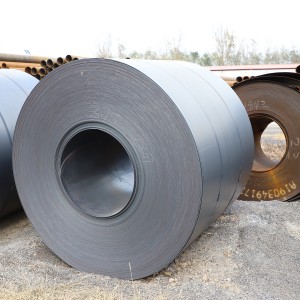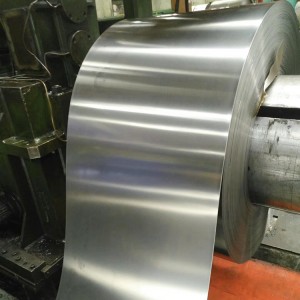1. Hot Rolling
Continuous casting slabs or initial rolling slabs as raw materials, heated by a step heating furnace, high-pressure water dephosphorization into the roughing mill, the roughing material by cutting the head, tail, and then into the finishing mill, the implementation of computer-controlled rolling, final rolling that is after laminar flow cooling (computer-controlled cooling rate) and coiling machine coiling, become straight hair rolls. The head and tail of the straight hair coil is often tongue and fishtail shape, thickness, width accuracy is poor, there are often wave-shaped edge, folded edge, tower and other defects. Its volume weight is heavy, the inner diameter of the steel coil is 760mm. (General pipe making industry like to use.) The straight hair coil by cutting head, tail, cutting edge and more than one straightening, leveling and other finishing line processing, and then cut plate or re-roll, that is to become: hot rolled steel plate, flat hot rolled steel coils, longitudinal cut strip and other products. Hot rolled finishing coils if the pickling to remove the oxide skin and oiled into hot rolled pickled coil. The figure below shows the hot rolled coil.
2. Cold Rolled
Hot rolled steel coils as raw materials, after pickling to remove the oxide skin for cold rolling, the finished product for the rolled hard volume, due to continuous cold deformation caused by cold hardening of the rolled hard volume of strength, hardness, toughness and plastic indicators decline, stamping performance deterioration, can only be used for simple deformation of the parts. Rolled hard coil can be used as raw materials for hot-dip galvanizing plant, because hot-dip galvanizing unit are set up with annealing line. Rolled hard coil weight is generally 6 ~ 13.5 tons, the inner diameter of the coil is 610mm. general cold rolled plate, coil should be continuous annealing (CAPL unit) or hooded furnace de-annealing treatment, to eliminate cold hardening and rolling stress, to achieve the mechanical properties specified in the standard indicators. Cold rolled steel plate surface quality, appearance, dimensional accuracy are better than hot rolled plate. The following figure shows the cold rolled coil.
The main difference between cold rolled vs hot rolled steel lies in the processing technology, scope of application, mechanical properties and surface quality, as well as price differences. The following is a detailed introduction:
Processing. Hot rolling is done at high temperatures, while cold rolling is done at room temperature. Hot rolling is rolling above the crystallization temperature, while cold rolling is rolling below the crystallization temperature.
Applications. Hot rolled steel is mainly used in steel structures or mechanical parts, including bridge construction, while cold rolled steel is more used in the automotive industry or small appliances, washing machines, refrigerators, etc., including construction materials.
Mechanical properties. Cold rolled mechanical properties are usually better than hot rolled, because the cold rolling process produces a hardening effect or cold hardening, resulting in cold rolled sheet surface hardness and strength is higher, but the toughness is lower, while the mechanical properties of hot rolled sheet is far less than cold rolled sheet, but has a better toughness and ductility.
Surface quality. The quality of the surface structure of cold rolled steel will be better than hot rolled steel, cold rolled products are harder and less ductile, while hot rolled products have a rougher, textured surface.
Specification thickness. Cold rolled coils are usually thinner than hot rolled coils, with the thickness of cold rolled coils ranging from 0.3 to 3.5 millimeters, while hot rolled coils range from 1.2 to 25.4 millimeters.
Price:Typically, cold rolled is slightly more expensive than hot rolled. This is because cold rolling requires the use of more sophisticated processing equipment and more complex process technology, and cold rolling treatment can get a better surface treatment effect, so the quality of cold rolled products is generally higher, the price is correspondingly higher. In addition, cold rolled steel in the production process requires more stringent processing technology and higher processing difficulty, the production equipment, rolls and other equipment requirements are higher, which will also lead to the rise in production costs.
Post time: Jan-02-2025








